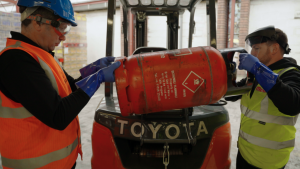Complete Powerpoint slide presentation for forklift instructors. Ready made training course
how to safely refill and change LPG cylinders on forklifts
 This article is by Brian O’Flynn, Technical Trainer at Calor. Here, he gives 5 simple steps to safely refilling and changing an LPG gas cylinder on a forklift truck.
This article is by Brian O’Flynn, Technical Trainer at Calor. Here, he gives 5 simple steps to safely refilling and changing an LPG gas cylinder on a forklift truck.
Refillable Forklift Cylinders
1. The first step is to ensure you are wearing the correct PPE. This is because LPG in its liquid form can give you a cold burn if it makes contact with the skin.
The correct PPE to wear when refilling a forklift truck cylinder is a face shield or visor, a long-sleeved top that is preferably made from cotton, and neoprene or nitrile gloves – preferably the gauntlets. You should also wear safety boots and a hi-vis vest.
2. When refuelling a refillable LPG cylinder, you should park up to three metres away from the bulk storage tanks; then apply the handbrake and turn the engine off.
3. Once you’ve checked the content gauge on your refillable LPG cylinder to see how much needs to be refilled, attach the filling hose and gun from the bulk tank installation to the filler valve on the cylinder. You should check the connection on both the hose and the filler valve to make sure they are in good condition.
4. Open the bleed valve that is on the refillable cylinder; once there is a small release of gas, you can start conveying liquid by using the dead man switch on the installation.
5. When you start seeing liquid appear, which will be shown with a white jet coming out of the bleed valve, stop filling immediately and close the bleed valve. Then depress the gun to release it and make sure the connection is depressurised. Once you’ve stowed the hose and gun away, return to the cylinder to put the filler valve cap back on.
Non-Refillable Forklift Cylinders
1. As mentioned above, wearing the correct PPE is vital when changing your gas cylinder.
The correct PPE to wear is a face shield or visor, safety boots, a hi-vis vest, a long-sleeved top that is preferably made from cotton, and neoprene or nitrile gloves – preferably the gauntlets.
2. With a non-refillable cylinder, park up your forklift truck, apply the handbrake and close the service valve on the cylinder before turning the engine off.
3. Wait for the engine to cut out, so you can close the service valve and disconnect the cylinder to remove it from the back of the forklift truck.
4. When fitting the new cylinder on the back of the forklift truck, we advise having someone assist you.
To check that the cylinder has been fitted correctly, make sure that it is secure; on the bottom of the cylinder, there is a white arrow which should be pointing downwards. A Calor Liquid Offtake Cylinder (LOT) cylinder is designed to give liquid propane offtake only when operating in the horizontal position.
5. Once the cylinder is safely secured, you can start the engine as normal.
Please note, this article is for raising safety awareness and is not a replacement for taking FLT safety training. If you’re interested in booking Calor FLT safety training for your employees, please email Calor on: CETraining@calor.co.uk
For more information on L. P Gas systems click here.
For further guidance see these videos on YouTube:
- How to Safely Refill a Forklift Truck LPG Cylinder: https://www.youtube.com/watch?v=dwam-docFys
- How to Safely Change an LPG Cylinder on a Forklift Truck: https://www.youtube.com/watch?v=JRQA_eVjMHE
Disclaimer. The legislative information contained on this web site is my interpretation of the law based on many years in the health and safety business. A definitive interpretation can only be given by the courts. I will therefore not be held responsible for any accident/incident/prosecution arising as a consequence of anyone using any information obtained from this web site.